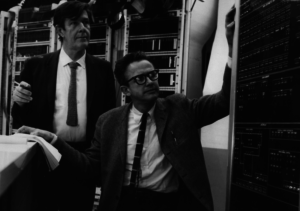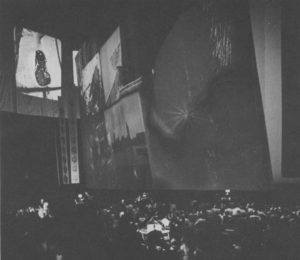
(John Cage and Lejaren Hiller working on HPSCHD)
HPSCHD by John Cage, a composer, and Lejaren Hiller, a pioneer in computer music, is one of the wildest musical compositions in the 20th century. Its first performance in 1969 at the Assembly Hall of the University of Illinois at Urbana-Champaign included 7 harpsichord performers, 7 pre-amplifiers, 208 computer-generated tapes, 52 projectors, 64 slide projectors with 6400 slides, 8 movie projectors with 40 movies and lasted for about 5 hours.

(First performance)
Before explaining further, imagine listening to this for five hours.
When I first listened to the piece at MoMA, it felt like a devil was speaking to be, but the composition is actually one of the early examples of randomly generated computer music.
HPSCHD (a contraction of the word ‘harpsichord’ into a computer language) was created in celebration of the centenary of the University of Illinois at Urbana-Champaign in 1967. The prerequisite of the work was to involve the computer in one way or another. Cage did not want the computer to serve simply as an automatic machine that makes his work easier, but he envisioned a process of composition in which the computer becomes an indispensable part.
The composition involves up to 7 harpsichord performers and 51 magnetic tapes that are pre-recorded with digital synthesis, which manipulates the pitches and durations of sounds in pieces by Mozart, Chopin, Beethoven, and Schoenberg. The music for a harpsichord is generated by the computer for each performers using Illiac II computer and two software created in Fortran computer language, DICEGAME, and HPSCHD.
DICEGAME is a subroutine designed to compose music for the seven harpsichords. It uses a random procedure created by Mozart called Dice Game which generates random music by selecting the pre-formed musical elements with dices.
The second software, HPSCHD, is responsible for the sounds that are recorded in the tapes. The program synthesized sounds with harmonics that are similar to those of a harpsichord. It used a random procedure from I-Ching or Book of Changes, an ancient Chinese divination text. It divided the octave into 5 ~ 56 parts and calculated each for the 64 choices of I-Ching procedure. I don’t completely understand how it works but that apparently allows 885,000 different pitches to be generated.
Each performance of HPSCHD is supposed to be different, due to randomly generated sound from the tapes and performers, the different number of tapes and performers, and different arrangement of all these parts. A performance can play all of the sounds at once, individually, or somewhere in between. The recorded version above is just one of the infinite number of variations.
Further research:
https://www.jstor.org/stable/3051496?seq=1#page_scan_tab_contents
(An academic journal from University of Illinois Press. You can use your NYU ID to access)
https://www.wnyc.org/story/john-cage-and-lejaren-hiller-hpschd/
(Interesting podcast on HPSCHD)

It was really interesting to read about HPSCHD, as I never thought about how computers could randomly generate music. I listened to a little of the MoMA piece, and I can definitely say that it sounds both disorganized and erratic. It would be great to find out more about Cage and Miller’s process in creating the composition.
John Cage was well known for his experiments with randomness and chance which led to chaotic sounding scenarios like the one you’ve linked to here, but also challenged the idea of what music is and can be.
Speaking of random, if you;re interested in a “true” randomness in your sketches, check out https://www.random.org for more.
The music that the HPSCHD creates is very interesting. I couldn’t listen to it for long (especially not 5 hours), probably because I’m used to listening to music that’s a little more organized haha. But it’s interesting to see this kind of randomly generated music…it makes you wonder what can actually be classified as music, rather than just random noises/sounds.
The music is really interesting, but I don’t think I could listen to this for 10 hours or even longer than 2 minutes because it’s very disorganized. Do you know what pushed him to make this kind of music or why he put so much randomness into it? Having a new sounds generated each time is unique, but I’m not sure if I would say it’s music or not.
I agree with everyone else so far; I dunno if I could listen to this for five hours, but it’s really cool how HPSCHD was original in that it challenges what we think of music by adding randomness into sound. It makes me wonder what’s considered “good” or “bad” randomness, as it seems like a fine line to walk.
This is very primitive software and I just find it amazing how far we’ve come from those days. More interesting is the fact that this earlier form of technology was used as an early form of electronic music and everyone seems to think its a bunch of sounds which is reasonable.
This is really cool Jei, and like some other people mentioned, I hadn’t thought about computers randomly generating music. It makes you question what constitutes music and what is just noise. I think that this level of randomness makes for a challenging listening experience, but could see a more controlled randomness creating some cool effects and music! I feel like it is a delicate line to walk, since we do have such customary ways we are used to hearing music, but just how randomness can be introduced into art and be very visually pleasing, I’m sure it is also possible to make very audibly pleasing music using randomness, just in proper moderation. Thanks for sharing, and sorry for the late comment.